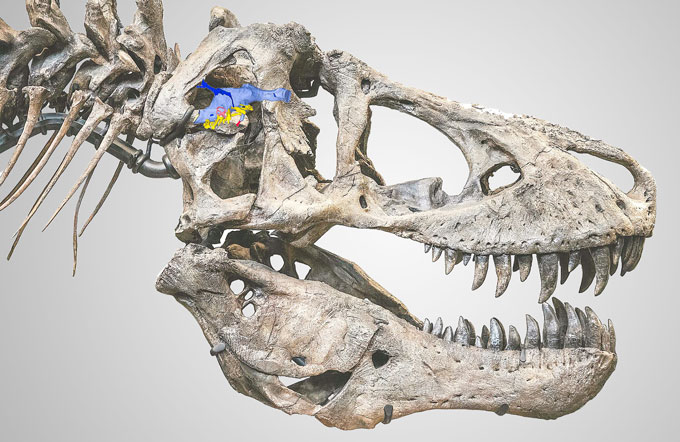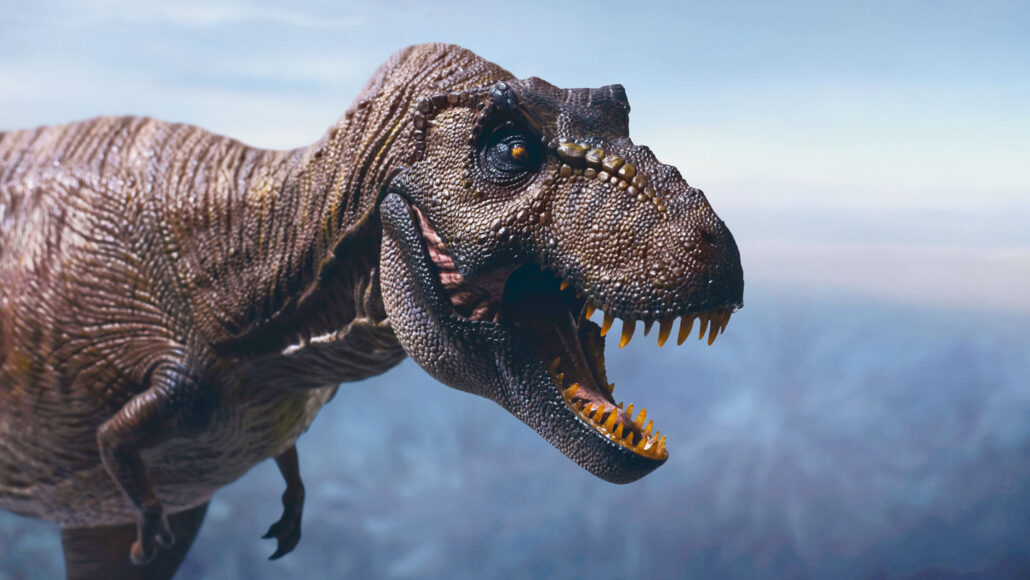Last year, the iconic dinosaur received a significant reevaluation. Neuroscientist Suzana Herculano-Houzel determined that the fearsome reptile had 3.3 billion neurons — nerve cells — in the front part of its brain. This discovery suggested that the T. rex’s brainpower was on par with modern baboons.
The implications were profound, hinting that the ancient predator might have had the cognitive capacity to develop culture and create tools. However, this claim faced skepticism and raised questions among the scientific community.
Recently, a new set of calculations has emerged, presenting a much lower neuron count.
According to this new study, dinosaurs like T. rex had closer to 360 million neurons in the telencephalon, a part of the forebrain involved in sensing, thinking, and coordinating motion. This lower count would place T. rex’s mental capabilities closer to those of crocodiles rather than baboons. An international team of researchers shared these findings on April 26 in The Anatomical Record. Herculano-Houzel, who is based at Vanderbilt University in Nashville, Tennessee, disagrees with the new calculations, citing a “fatal mistake” that leads to the lower count.
To estimate an animal’s neuron count, it’s crucial to understand the density of brain cells, which varies significantly across species. Since brain cells are not well-preserved in fossils, scientists must estimate neuron densities based on modern relatives of extinct animals.
Here’s where the issue arises: T. rex belonged to a group of dinosaurs known as theropods, related to both reptiles and birds. However, these two groups have vastly different neuron densities. Reptiles have fewer neurons per unit volume of brain compared to birds. Researchers must decide whether to base their calculations on birds, reptiles, or a combination of both when estimating neuron counts in extinct theropods like T. rex.
For her 2023 study, Herculano-Houzel analyzed the relationship between brain size and body mass for approximately 30 different dinosaurs. She then compared these figures to modern birds and reptiles, using ancient bird families to suggest that theropod brains were more like those of birds. Thus, she used modern bird densities for her calculations.
This assumption is flawed, says Cristián Gutiérrez-Ibáñez, a comparative neuroscientist at the University of Alberta in Edmonton, Canada. He argues that birds vary widely in their brain-to-body mass ratios. His team included a broader range of modern birds in their new study, resulting in a T. rex brain-to-body ratio closer to that of scaly reptiles.
Gutiérrez-Ibáñez also points out another issue with Herculano-Houzel’s study: she assumed that dinosaur brains filled the entire braincase, similar to modern birds. However, the brains of T. rex and many other dinosaurs floated in fluid, more like modern crocodiles. Recalculating the brain size based on this assumption significantly reduced the neuron count, with the estimate for the telencephalon dropping from 3.3 billion to 1.2 billion. Using reptile neuron density further reduced the count to between 245 million and 360 million.
Herculano-Houzel counters that her study did account for the fact that dinosaur brains did not fill the braincase. She also argues that it doesn’t make sense to consider the brain-to-body ratios of a wide variety of modern birds. She focused only on birds closely related to dinosaurs. Including birds like pelicans and penguins, which have very different brain-to-body ratios, led the new study to incorrectly conclude that T. rex was more like modern crocodiles.

Regardless of neuron count, T. rex’s overall brainpower remains a topic of debate. Amy Balanoff, an evolutionary biologist at the Johns Hopkins School of Medicine in Baltimore, Maryland, who was not involved in either study, notes that even if T. rex had neuron density similar to primates, those neurons likely helped the dinosaur move its large body or process sensory information. For example, the smell centers in the T. rex forebrain were massive, suggesting that many neurons were devoted to processing odors. There is little evidence that these early dinosaurs used their brains for tool-making or developing culture.
Gutiérrez-Ibáñez agrees. “Having the same number of neurons as a primate does not make you a primate,” he says. To suggest that these dinosaurs used tools or were as intelligent as primates is “a large leap.”
Nonetheless, Herculano-Houzel’s work has been valuable in sparking discussion. “I appreciate the original study for starting the conversation,” Balanoff says. “You can’t advance science without putting the data out there.”
